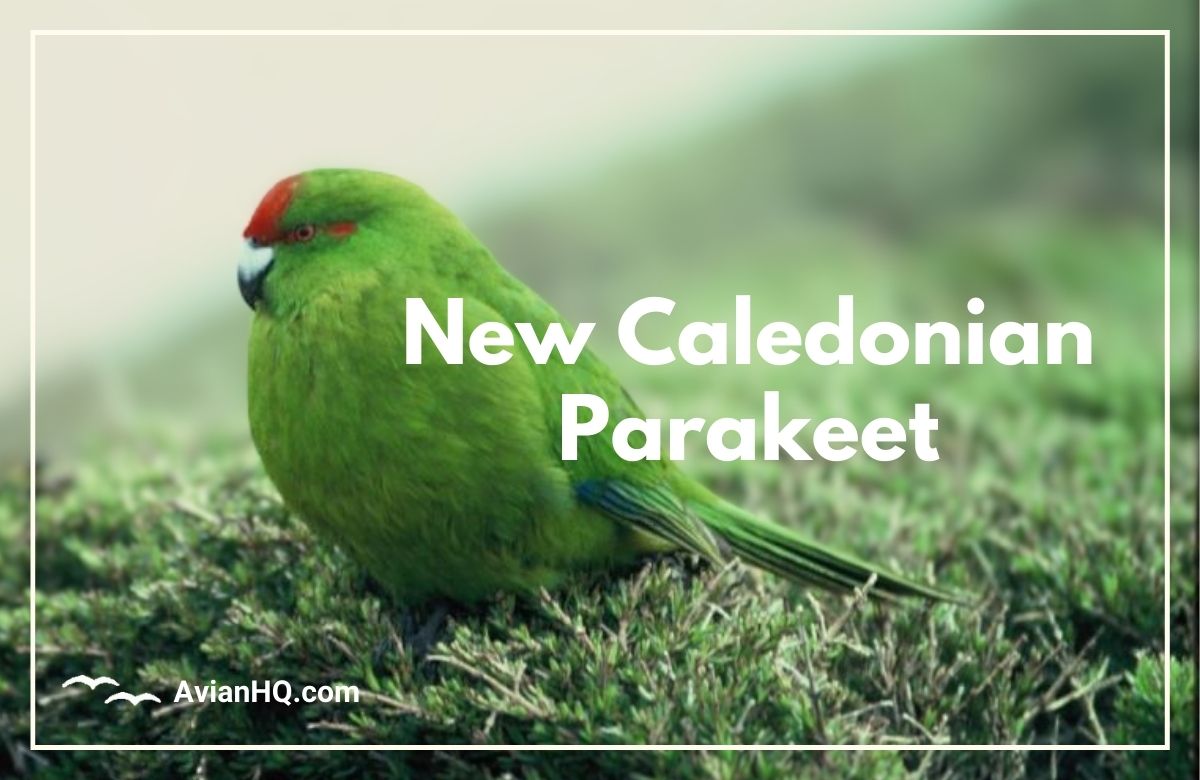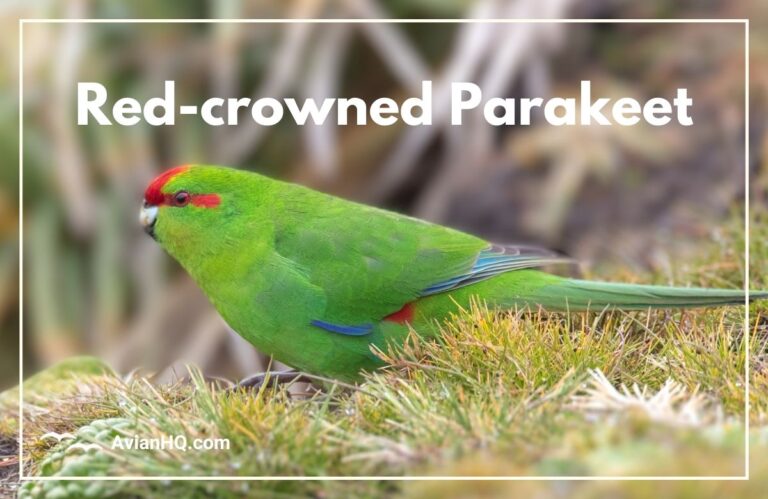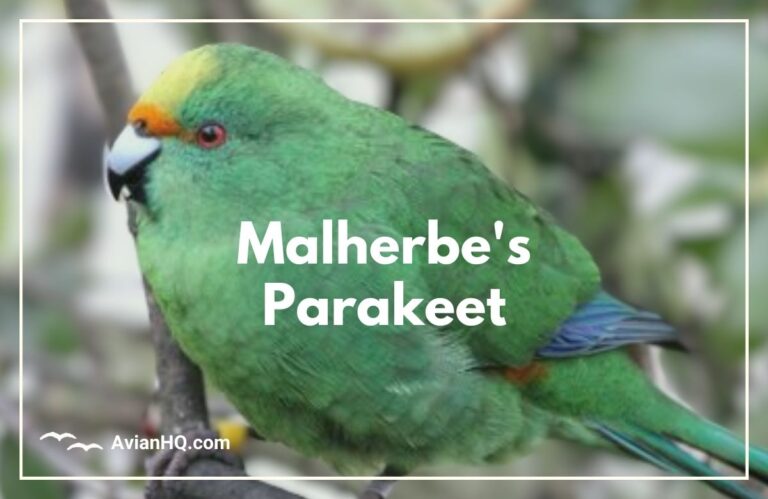New Caledonian Parakeet (Cyanoramphus saisseti)
You first lay eyes on the small, bright green bird with a shock of red feathers on its forehead. It cocks its head, eyeing you curiously with inky black eyes. The bird hops closer along the rainforest branch, and you spot flashes of brilliant blue on its wings – it’s a New Caledonian Parakeet!
These rare parrots only live on the Pacific island of New Caledonia, located east of Australia. Standing barely 5 inches (13 cm) tall, they have an oversized personality packed into a petite frame. New Caledonian Parakeets are extremely social and live in small, noisy groups that flit through the upper canopy of tropical forests.
These parrots have faced hardship recently. Over the last 30 years, more than 90% of their population has disappeared. New Caledonian Parakeets now number less than 1,000 total birds remaining in the wild. Their beautiful green and red feathers even earned them a spot on New Caledonia’s postage stamps before they became endangered.
“New Caledonian Parakeets act like typical naughty parrots – loud, comical, and endearing.”
In this article, you’ll uncover what makes these parrots special, from their unique taxonomic history to unusual courtship behaviors. You’ll also learn ways that scientists and conservationists are working to protect these parrots and bring their numbers back from the brink. So let’s spread our wings and dive into the treetops to unlock the secrets of New Caledonia’s iconic parakeets!
History and Taxonomy
New Caledonian Parakeets puzzled scientists when they were first documented by explorer Jules Verreaux in the 1860s. Their bright red foreheads seemed to match other parakeets found in Australia and the islands north of New Zealand. Yet something about them didn’t quite fit.
These birds were originally classified in the genus Cyanoramphus, grouping them with other parakeets living throughout the southwestern Pacific. But in 1997, scientists reclassified them to a new genus Eunymphicus based on certain skeletal differences.
Further genetic studies muddled things even more. Analysis showed New Caledonian Parakeets were more closely related to some of their Cyanoramphus cousins than previously thought. In 2021, scientists came full circle and returned the parakeets back to the original Cyanoramphus genus based on evolutionary relationships.
Through all this reshuffling, one fact has become clear – New Caledonian Parakeets are still their own distinct species. Their genetic uniqueness mirrors New Caledonia’s isolation over 900 miles (1,500 km) from any continental landmass. This remoteness allowed New Caledonian Parakeets to follow their own evolutionary path.
Physical Appearance
The bright green feathers covering a New Caledonian Parakeet’s body and tail give away its parrot family ties. But several unique physical traits help these petite 5-inch (13 cm) tall birds stand out.
Their common name comes from the vibrant crimson patch of feathers spreading across the forehead and around the eyes. This red facial “mask” is a distinctive look the males proudly display when courting females.
Peek underneath the wings and you’ll spot another flash of color – rich royal blue lining the primary wing feathers. This iridescent hue glows brightly when sunlight hits at the right angle.
These parakeets do show some dimorphism between genders. Males tend to have more extensive red facial markings paired with brighter green upperparts. Females have slightly duller plumage overall. But personality-wise, both genders are equally gregarious and high-strung.
Some key physical adaptions help New Caledonian Parakeets thrive in their forest home. Their swift, agile flight allows them to navigate quickly through dense treetops. Zygodactyl feet with two toes facing forward and two facing back perfectly grip branches. And a strong curved beak cracks open tough native fruits and seeds.
Habitat and Distribution
New Caledonian Parakeets live up to their “island endemic” status – they are found nowhere else in the world besides New Caledonia. This slice of a tropical island lies isolated in the southern Pacific Ocean, roughly 750 miles (1,200 km) east of Australia.
The island has a mainland portion simply named Grande Terre, meaning “large land” in French. This nickname hints at the diversity of landscapes packed into the island’s 3,600 square miles (9,390 square km). Rugged mountains covered in dense tropical rainforest dominate the interior, while patches of savanna grasslands trim the coastline.
It is within Grande Terre’s forested interior that New Caledonian Parakeets make their home. They stick to warmer lowland rainforest and woodland regions below 3,000 feet (900 m) in elevation. The parakeets particularly flock to valley forests with taller, mature trees.
These agile parrots spend nearly all their time up in the forest canopy feeding, socializing, and nesting in tree cavities. You’re more likely to hear their raucous squawks first before spotting a flock bursting through the treetops. Finding these endangered birds takes patience as they blend into the green forest backdrop.
Diet and Feeding
New Caledonian Parakeets aren’t picky eaters. As omnivores, they’ll sample just about anything edible from the surrounding forest buffet. Their diverse diet reflects the need to thrive on an isolated island with limited food choices.
You’re most likely to catch these parakeets foraging for various native fruits and berries. Figs, plantains, and an endemic fruit called niaouli feature as forest favorites. To switch things up, the parakeets also nibble on fresh buds, seeds, and nectar.
This rainbow-hued flock zips through the rainforest canopy targeting their next tasty snack. Using their curved upper bill like a Swiss army knife, they can effortlessly slice open hard fruits and extract seeds.
Their feeding isn’t always welcomed, however. Farmers consider New Caledonian Parakeets crop pests for damaging important food sources like banana, coconut, and mango crops. But the destruction works both ways. With fewer mature fruit trees left in the shrinking rainforest, more parakeets turn to raiding farms out of desperation.
The parakeets do offer an upside beyond squawky pest – they serve as critical native forest pollinators. As they travel from tree to tree feeding, pollen clings to their heads and bellies and rubs off on the next blossom. This ensures a future supply of forests fruits and seeds.
Breeding and Reproduction
Around October when fruit trees begin blossoming, New Caledonian Parakeet couples prepare for their own season of new beginnings. These monogamous birds pick long-term partners that stay paired for life.
To woo potential mates, males show off bright colored facial markings and shiny wing feathers. If successful, pairs then inspect nesting cavities high up in the rainforest canopy carved out by woodpeckers or termite damage.
Females lay small clutches of only 3-4 round, chalky white eggs. Both parents then share duty incubating the eggs, taking shifts over the 22-24 days until they hatch. If food is plentiful, the pairs may raise two broods back-to-back.
The helpless hatchlings emerge nearly naked and blind, relying completely on their parents for survival. Good thing New Caledonian Parakeets make such attentive caregivers, frequently returning to the nest with nutritious fruits and seeds to feed the chicks.
Around 6-7 weeks after hatching, the young are fully fledged and ready to leave the nest. But they’ll stick close to their parents learning how to forage and avoid predators. Within their first year, the young parakeets will join a flock of other singles looking to someday woo their own partner when mature.
Behavior and Ecology
From first glance, New Caledonian Parakeets showcase all the classic parrot behaviors – intelligent, social, comical, and loud. They pass their days in small flocks of less than 20 birds foraging, preening, squabbling, and shrieking to each other.
You’re most likely to find them actively feeding early morning and late afternoon. The hottest parts of the day are reserved for siestas hidden out of the sun. But quick tropical downpours might send them scattering for cover before returning promptly to their activities.
Unlike other parrot species, New Caledonian Parakeets seem naturally shy and wary of humans. But amongst themselves they have no sense of stranger danger. These innately trusting birds show no fear towards introduced predators like rats or snakes that now infiltrate their forest homes.
That’s partly why invasive mammalian predators have become so devastating. Beyond habitat loss, they are the main reason New Caledonian Parakeet numbers have nosedived close to extinction levels. Rats raid nests full of eggs and chicks while feral cats ambush unwitting adults.
For millions of years these parakeets evolved lacking mammalian predators. So when rats came barging in as stowaways on ships in the 1800s, the parakeets had zero defense strategies to employ. This inability to coexist with invasive species continues to threaten their slim chances of survival.
Conservation Status
New Caledonian Parakeets have the unfortunate distinction of being classified as Endangered by the International Union for Conservation of Nature (IUCN). This troubling status indicates the birds face a very high risk of going extinct in the near future.
Best estimates suggest only 500-1,000 New Caledonian Parakeets currently survive across their native range. That represents a staggering 90% drop in their total population over the last 30 years alone.
This sharp decline stems from the double-punch of habitat loss and invasive predators. Expanding nickel mining and logging operations continue fragmenting and degrading suitable forest. And mammals like rats and feral cats infiltrate what habitat remains, devastating native wildlife unused to their presence.
Other threats like illegal poaching for the pet trade and climate change loom ominously for this Endangered species as well. New Caledonian Parakeets have a constricted range limited to one medium-sized island, leaving them highly vulnerable. If storms or drought knock out their remaining habitat, they have nowhere else to shelter.
Conservationists are taking action, but the clock is ticking. Survival depends on safeguarding remaining rainforest corridors and controlling invasive mammal numbers. Captive breeding programs provide an important backup, but the ultimate goal is restoring self-sustaining wild populations.
The coming decades will determine whether New Caledonia’s beloved green and red parakeets rebound or fade away forever into the forest canopies of history.
Cultural Significance
The vibrant green, red, and blue plumage of New Caledonian Parakeets has left a cultural impression spanning far beyond their remote Pacific island home. These tropical birds have become interwoven into local artwork, legends, and symbols of pride.
The parakeets’ reputation and unique appearance earned them recognition on a New Caledonian postage stamp series in 1969. This commemorated native birds when populations were still robust and thriving.
More recently, a stylized red-masked parakeet served as the official logo for environmental programs on Grande Terre. Local groups like Programme Forestier provincial adopted the graphic to showcase biological diversity conservation across New Caledonia.
According to legend, New Caledonian Parakeets got their bright red facial markings from the blood of an ancient warrior. After slaying his enemy in battle, the warrior used a parakeet’s feathers to clean the blood from his war club. The crimson colored feathers remained as a symbol of victory and pride for his descendants.
The very name New Caledonians have for their iconic island parrot further demonstrates fond cultural connections. In Nemi, the native language, they are called “Notou” which loosely translates to “little red head” – an apt description for these crimson-crowned birds.
As “Notou” populations decline, they risk becoming no more than artwork, postal history, or legend. Ensuring New Caledonian Parakeets thrive again in neighborhood forests will maintain beloved cultural links for generations to come.
Conclusion
In your brief rainforest encounter with New Caledonian Parakeets, you were left with a vivid impression – petite and colorful, comically playful, yet surprisingly vulnerable. These unique island endemic parrots have personality to spare, but their very existence now teeters on the brink.
Once locally abundant, only an estimated 500-1,000 New Caledonian Parakeets remain. Predation from invasive mammal species along with ongoing habitat loss have decimated populations by over 90% in recent decades. Their distinctive crimson facial markings even inspired New Caledonian postage stamps before the parakeets became Endangered.
Yet hope persists for saving these birds as conservation actions slowly ramp up. Habitat restoration projects are underway to connect fragmented rainforest corridors and control populations of destructive invasive predators. A captive breeding program safeguards valuable genetic diversity if reintroduction back to the wild becomes necessary.
The outlook remains cloudy, but local biologists are determined to ensure New Caledonian Parakeets prosper across their island home once more. As the signature rainforest bird, their frenetic flocks offer an audible reminder of wild Grande Terre. By restoring endangered “Notou” parakeets, New Caledonians preserve links to their unique natural and cultural heritage.







